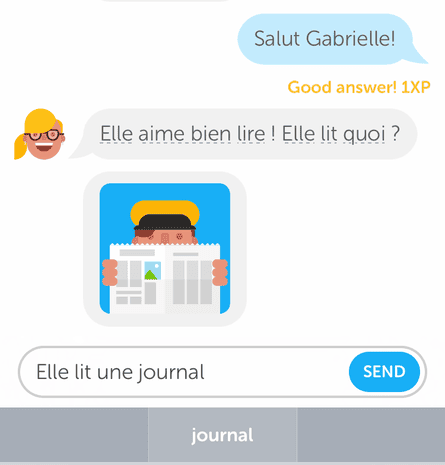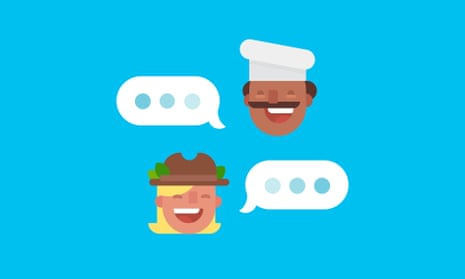Chatbots suck. We all know it. If you want to get something done with a computer, it turns out, there are better ways to do it than laboriously type out conversational sentences to be read by a programme with a shaky grasp of the language and a gratingly affected sense of humour.
So I’m as surprised as anyone that for the past week, I’ve started every morning with a 10 minute conversation with a chatbot. In French.
The bot is the creation of Pittsburgh-based language-learning startup Duolingo, and it’s the first major change for the company’s app since it launched four years ago. In that time, the service has gained 150 million users, and stuck stubbornly to the top of the educational app charts on every platform it’s available on.
If you haven’t used Duolingo, the premise is simple: five to 20 minutes of interactive training a day is enough to learn a language. That training takes the form of a collection of quick tasks, collected around different vocabulary and grammatical goals such as “time”, “occupation” and “adverbs”. In one session, you may be asked to write the English translation of a phrase by tapping the correct words, type out French phrase you hear, pair words together, and repeat a phrase accurately.
The whole thing comes together with a smattering of gamification, rewarding users for hitting their goals every day and encouraging them to keep up with friends and family who are trying to improve themselves. It works, too: every email I receive telling me my mother is ahead of me prompts a furious burst of cramming.
That success – along with the fact that Duolingo is effective for, you know, learning languages – means that the app’s creators have had very little time over the past few years for anything other than dealing with its meteoric growth, according to the company’s co-founder and chief executive, Luis von Ahn.

“We launched Duolingo four years ago,” he said on the phone, a few days before the chatbot feature was rolled out to all the company’s users. “At the time, it was pretty revolutionary, because it was the first app that was completely free to learn a language, and pretty quickly we became the number one most downloaded education app.
“It grew a lot. And we spent the next three years, first of all scaling, to be able to serve more than 100 million users. So that’s a big deal. And also tuning it: we did a lot of A/B tests, where we tested things like ‘should we teach you plurals before adjectives, or adjectives before plurals’.”
But a year ago, the frantic pace had slowed down enough that Duolingo could ask more fundamental questions about what it takes to learn a foreign language.
“A very common request that we get is people want to practice conversation,” von Ahn says. “And there’s a beautiful idea, which is if you’re an English speaker learning French, we should pair you up with a French speaker learning English, and maybe the two of you can kind of teach each other.
“It sounds like a really elegant idea, and we’ve tried this, and every time we’ve tried this we find that most people don’t like it. The reason is because I’d say about three-quarters of the people we try it with are very embarrassed to speak in a foreign language with another person.”
For the people it works for, it really works. In fact, von Ahn says, the less you worry about embarrassment, the better you tend to be at learning languages. But it’s no good building a language-learning tool that only helps a small proportion of people.
“We thought one way to get around that problem is to pair people up with a computer,” he said. “As far as we can tell, computers can’t judge us.”
The problem, of course, is that computers can’t really understand us either. Anyone who’s spent much time with a natural-language chatbot will have grown tired of the many different ways the programmers wrote “I’m sorry, I didn’t understand that”, and for an app that is supposed to remove some of the frustration from learning a language, that’s a problem.
But when life (and the inherent limitations of natural language processing) gives you lemons (and parsing errors), you make lemonade. The needs of a language-teaching chatbot are rather different from other applications, and a big difference is that it’s not only OK, but entirely necessary, for the chatbot to gently guide you through what you should say.

In practice, that means that as you type your responses to the chatbot, autocomplete kicks in much harder than normal – and if the word isn’t recognised by the bot, you simply can’t send it. Often, that will be because you’re trying to send a word that doesn’t exist, or that you’ve misunderstood the question and are going off-topic in response, so being pushed back on track is a helpful thing.
There’s still room for error, of course. There’s no help in picking the correct gender, for instance, nor in knowing which whether to say “droit” or “gauche” to someone asking directions.
At the same time, you do occasionally hit a limitation which feels a bit strict. In a roleplay in a French cafe, for instance, I was outraged not to be able to ask for un verre du vin, having to settle for un cafe. But von Ahn promises improvement there.
“We’re tracking everything that people enter. If the chatbot asks you what you want to drink, and you start typing ‘tequila’, we’ll spot that, even if you delete it before you’ve finished the word.” If the rejected words are plausible answers, the bot gets updated to have a wider range of potential responses.
The bot is text-only for the time being (it talks to you, but you have to type responses), but the plan is to introduce a fully spoken version in the future. That will, necessarily, reintroduce some of the dreaded “I didn’t understand that” errors, which is part of the reason for it being held back at launch.
It’s a small start: The chatbot is live in the latest version of the iOS app only, in just three languages: French, Spanish and German (and only for learners who speak English). There are about 40 potential conversations in French, and if you race through them, that’s it. But the plan is to grow the number rapidly.
“We’ve built up a process where we can build a new conversation every two days,” von Ahn says. But in the long run, the plan isn’t just to have a lot of potential conversations piggybacking on the main app: it’s to have one chatbot, that is the main app. By 2020, “my dream is for Duolingo to be as efficacious as a human tutor. If you were to spend thousands of dollars on a human tutor, we want Duolingo to be as good as that” he says. “In particular, I think it’s going to look a lot like a chatbot; a significantly smarter one.
“We’ve done the measurements: we know we’re as good as a classroom, a standard high-school classroom in the US. In a standard US classroom, kids are getting a minute of conversational practice a day. But we would like to be as good as a human tutor, and that’s where we want to go.”
